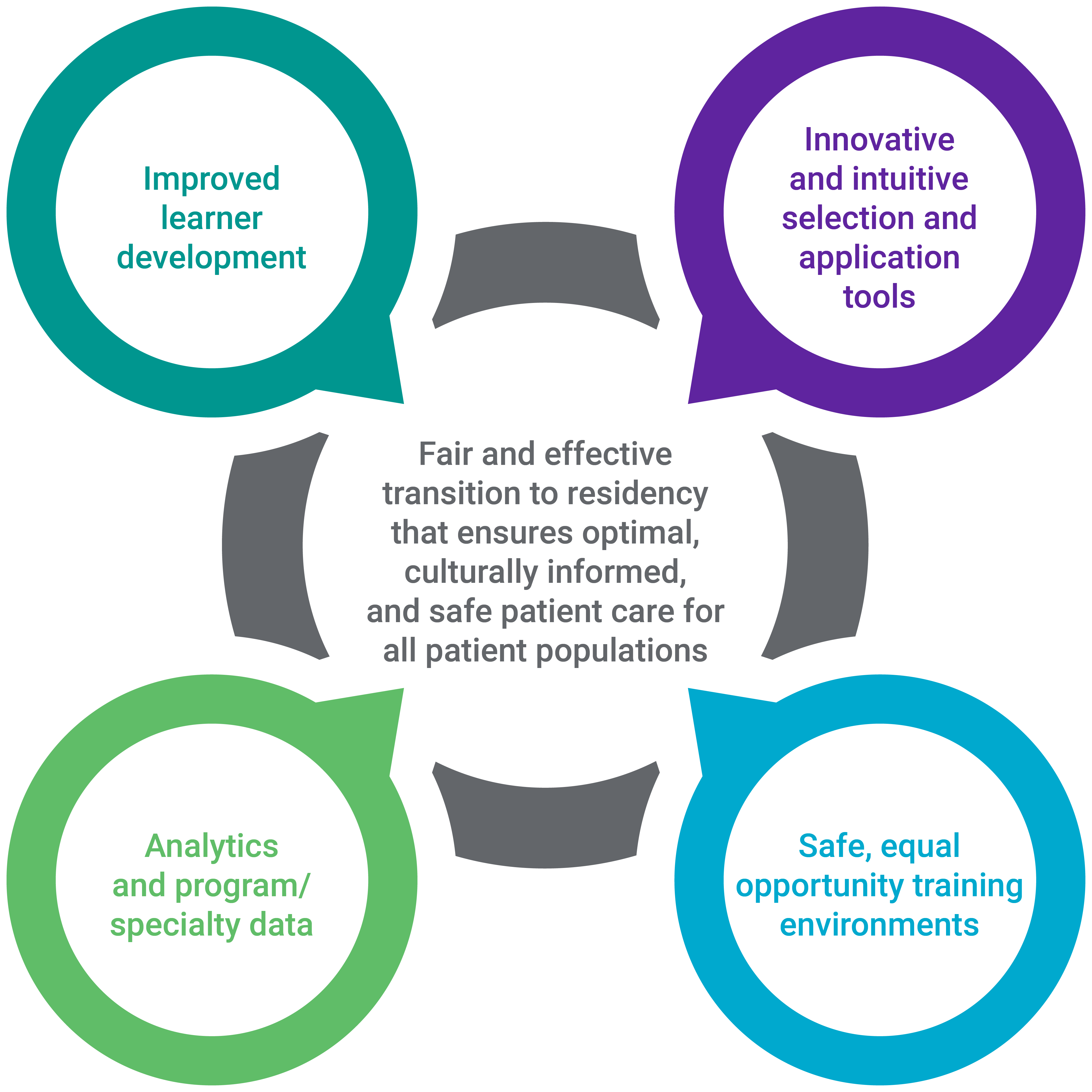The Undergraduate Medical Education-Graduate Medical Education Review Committee’s (UGRC) Recommendations for Comprehensive Improvement of the UME-GME Transition report reaffirms the AAMC’s commitment to achieving an equitable and effective transition to residency that ensures optimal, culturally responsive, and safe patient care for all patient populations. The AAMC has identified where our mission, Strategic Plan, and existing programs interact and support the concepts and themes addressed in the UGRC recommendations. This page outlines our priorities and guiding principles as we embark on this important work.
Transition to Residency Priorities

Improved learner development
- Strengthen the learning continuum to prepare applicants to be ready for residency and for programs to receive and educate residents.
- Assure learner competence and readiness for residency training.
- Improve trust between the UME and GME communities.
Desired outcomes
- Applicants are prepared to transition to their supervised practice, understand the commitment, and are ready for their residencies.
- Programs are prepared and resourced to train doctors from differing backgrounds and viewpoints.
Innovative and intuitive selection and application tools
- Provide a suite of products, resources, trainings, research, and tools that are evidence-based, support holistic review in the residency/fellowship process, and are adaptable to the changing needs of the community.
- Reduce reliance on licensure exam scores.
- Improve trust between the UME and GME communities in the selection process.
- Promote evidence-based selection processes, practices, and policies that help ensure equal opportunity for each applicant.
Desired outcomes
- The available tools are reliable, easily accessed, and used by applicants, program staff, and advisors to foster holistic review.
Analytics and program/specialty data
- Provide data, information, and experiences that help applicants make informed decisions about their futures (and the informal and formal advisors who support them).
- Improve transparency to students about the selection process.
- Optimize congruence between applicants’ goals and programs’ missions for high-quality patient care.
- Improve information to students about specialty choice.
Desired outcomes
- Data is available and delivered in a format that allows applicants to identify first specialty then programs that align with their goals and values as future physicians.
- Opportunities for experiencing different specialty pathways are accessible to students.
- Advisors are trained and have tools/resources to effectively support all their students.
- There are a reduced number of applications per applicant.
Safe, equal opportunity training environments for all
- Create and promote UME clinical learning environments (and transition process) in which all learners feel welcome, safe, and valued.
- Address multiples sources of bias throughout the transition process.
- Promote fairness regardless of applicant type.
Desired outcome
- AAMC transition to residency efforts help to grow and strengthen the physician workforce by promoting accessible learning and workplace environments in which everyone feels included, respected, and valued for their contributions.
Transition to Residency Guiding Principles
The AAMC is dedicated to successfully supporting the selection, transition, and development of a capable and effective physician workforce that has a broad range of skills and perspectives as part of the transition to residency. The AAMC must demonstrate reliability and integrity in all that it does to ensure a workforce that is optimally prepared to care for patients, caregivers, and communities who represent a multitude of backgrounds and health care needs. With its mission as its driver — to improve the health of people everywhere — the AAMC is committed to understanding and evolving the transition to residency process through its programs, from ideation, development, and testing, to evaluation and reliability. Innovation across the continuum, both within and outside of the AAMC, should be kept in focus to ensure alignment and identify conflicting efforts in this context.
Given the rapidly changing environment, the AAMC must collaborate and co-create with the stakeholder community (medical students, medical schools, residents, and residency programs) and peer organizations to develop and assess new ideas in a transparent, expeditious manner. However, it is critical that these ideas and opportunities for collaboration are evaluated by the AAMC across a set of guiding principles in order to prioritize efforts and ensure cohesiveness and alignment with the AAMC’s values. As a member organization that directly reflects the transition to residency stakeholders, the AAMC’s accountability in these efforts arises from the community through its organizations, groups, and councils, as well as the peer organizations supporting these constituents.
The AAMC will make decisions about transition to residency efforts using the following guiding principles:
- Balance the needs of key stakeholder groups — learners, medical school advisors, residency program directors, and Accreditation Council for Graduate Medical Education (ACGME)-designated institutional officials — to the greatest extent possible and ensure that the AAMC and its GME partners are utilizing recent information regarding the needs, motivations, and desires of each of these stakeholder communities (and their associated subcommunities).
- Provide learners with a positive, personalized experience as they navigate the transition to residency, recognizing their investment and vulnerability in this process. Any innovation efforts must promote the interests of learners in terms of improving information transparency, removing obstacles, reducing financial burdens, and enhancing positive outcomes.
- Ensure reliable, efficient solutions and intuitive experiences for residency programs, as they are the primary driver in determining both the criteria and processes by which learners will be evaluated. The collective use of the Electronic Residency Application Service® (ERAS®) across residency programs enables data compilations that drive broad-scale review, research, and refinement to foster continuous improvement and measure impacts of interventions.
- Analyze the underlying and proposed structures, systems, and processes of each innovation effort to ensure that it promotes positive impacts for stakeholders. An innovation must not impede any efforts in expanding the breadth of perspectives and experiences found within the physician workforce or providing safe and welcoming learning and workplace environments, to ensure equal access to opportunities for all.
- Focus on improving the process for learners, programs, and schools to strengthen well-being and minimize their financial burden in the transition to residency process.